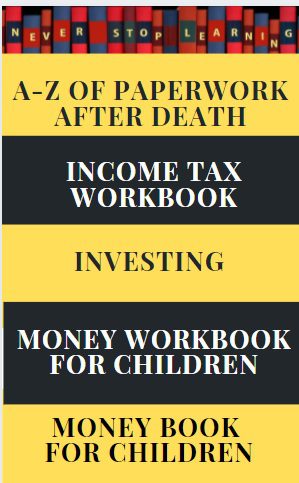The Global Carbon budget ranks India the fourth highest emitter of carbon dioxide, the Indian Council of Medical Research (ICMR) attributes one in eight deaths in India to air pollution and the World Health Organization (WHO) blames pollution for killing the highest number of under-5 children in India. What is Air Pollution? How is it Measured, WHO Report on Air Pollution, Face Masks and Air Purifiers
Table of Contents
Air Pollution is Deadly
“The world has turned the corner on tobacco. Now it must do the same for the ‘new tobacco’ – the toxic air that billions breathe every day,” said Dr Tedros Adhanom Ghebreyesus, the WHO’s director general. “No one, rich or poor, can escape air pollution. It is a silent public health emergency.”
In 2017, air pollution accounted for 12.4 lakh deaths in India, which included 6.7 lakh deaths due to outdoor particulate matter air pollution and 4.8 lakh deaths due to household air pollution. Over half of the deaths due to air pollution were in persons less than 70 years of age, the report said. With 18% of the global population, India suffered 26% of premature mortality and health loss attributable to air pollution globally.
Airpocalypse II, a Greenpeace India report, released in January 2018, reveals that 228 cities have not been compliant with the annual permissible concentration of 60μg/m³, which is prescribed by Central Pollution Control Board (CPCB) under the National Ambient Air Quality Standards (NAAQS);
Out of 630 million, close to 550 million people live in areas exceeding national standards for PM10 including 180 million living in areas where air pollution levels are more than twice the stipulated limit; Air pollution scenario is bad in many cities in India. In winter it becomes worse in many cities like Delhi.
How to measure Air Pollution: Assessment Quality Index
Air pollution scenario is bad in many cities in India. In winter it becomes worse in many cities like Delhi.
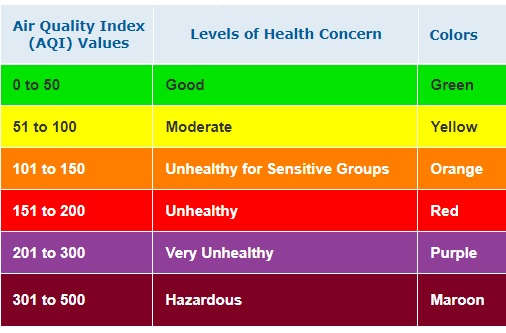
Air Quality Assessment Index
Outdoor Pollutants and their effects
- Carbon Monoxide colourless, odourless • produced when carbon does not burn in fossil fuels • present in car exhaust • deprives the body of O2 causing headaches, fatigue, and impaired vision
- Sulfur Dioxide • produced when coal and fuel oil are burned • present in power plant exhaust • narrows the airway, causing wheezing and shortness of breath, especially in those with asthma
- Nitrogen Dioxide • reddish, brown gas • produced when nitric oxide combines with oxygen in the atmosphere • present in car exhaust and power plants • affects lungs and causes wheezing; increases chance of respiratory infection
- Ground Level Ozone: at the upper level, ozone shields Earth from sun’s harmful UV rays but at ground level, ozone is a harmful pollutant. It is formed from car, power and chemical plant exhaust. It irritates respiratory system and asthma; reduces lung function by inflaming and damaging the lining of lungs
- SMOG is a combination of words smoke and fog, occurs often with heavy traffic, high temperatures, and calm winds. It is a combination of gases with water vapour and dust. It forms when heat and sunlight react gases (photochemical smog). It Limits visibility • Decreases UV radiation • Yellow/black colour over cities • Causes respiratory problems and bronchial related deaths
- Particular Matter: particles of very small sizes, smaller than the hair, that are released into the atmosphere. The sizes of particles that are tracked are PM 2.5 and PM 10 which refer to their sizes in micrometre. The image below shows the comparison of size of various particles. These are released from fossil fuels, dust, smoke, fog, etc. They can build up in the respiratory system and aggravates heart and lung disease; increases the risk of respiratory infection.
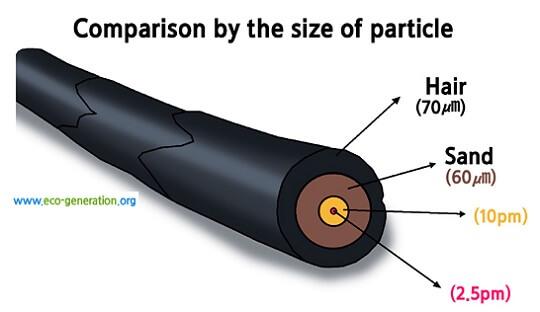
What is Particulate Matter PM 10 and PM 2.5
Measuring Air Quality in India
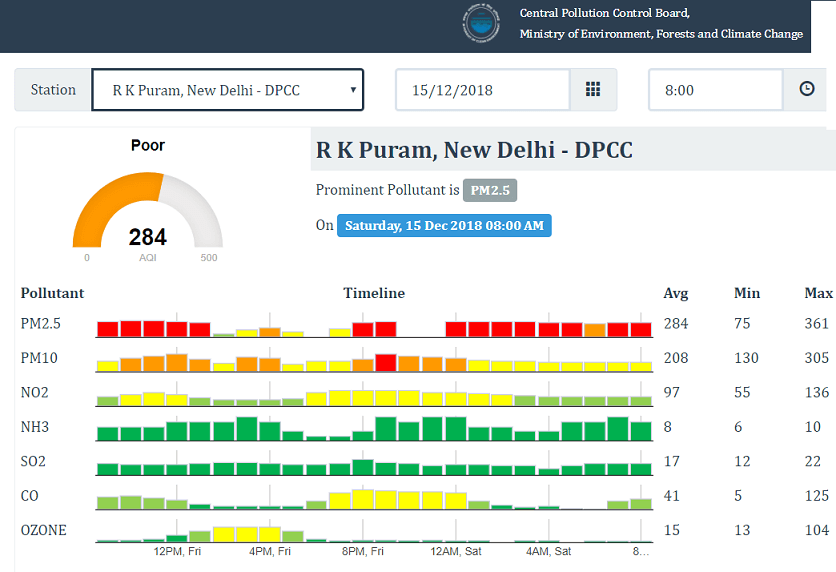
Measuring Air Pollution in India
Indoor pollutants and their effects
Indoor air pollution is largely the result of human activity, such as tobacco smoking, burning fuel for heat or cooking, the use of cleaning materials and solvents, and even breathing. People spend most of their time indoors, so the quality of indoor air has major implications for health. The air inside the conditioned space can be substantially more polluted than outdoor air.
- Indoor air pollution can contribute to a wide spectrum of respiratory health effects, from allergic sensitisation to cancer.
- Natural pollutants such as allergens, dampness and mould, and radon, can also have significant health effects.
Symptoms of poor indoor air quality are very broad and depend on the pollutants. They can easily be mistaken for symptoms of other illnesses such as allergies, stress, colds and influenza. The most common symptoms are: coughing, sneezing, watery eyes, fatigue, dizziness, headaches and upper respiratory congestion
Air contaminants are particles, liquids, and gases in the air which have harmful chemical properties that affect our health. Some of the substances floating around the home are.
- Microbes: germs, viruses, bacteria, and mold spores
- Odours: cigarette smoke, litter boxes, cooking, body, and pets
- Gases and Chemical Fumes (volatile organic compounds – VOC’s): benzene, cigarette smoke, formaldehyde, nail treatment products, etc.
- Particulates: allergens, dust, dust mites, pollen, pet dander, particles in smoke
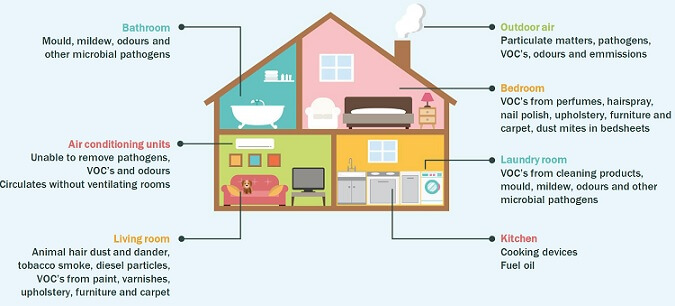
Indoor Air Pollutants
Video on Air Pollution 101 by National Geographic
This 4-minute video talks about What is air pollution? Learn how greenhouse gasses, smog, and toxic pollutants affect climate change and human health.
WHO Report on Pollution
Air pollution is the ‘new tobacco’, warns WHO head. Each passing month sees new studies showing further harms of toxic air, with recent revelations including a “huge reduction” in intelligence, millions of diabetes cases and the first direct evidence of pollution particles in mothers’ placentas. The cost of the lost lives and ill health caused is also a colossal economic burden: $5tn a year, according to a World Bank report
World Health Organization (WHO) database of more than 4,300 cities and settlements in 108 countries shows Indian cities such as New Delhi, Varanasi and Patna were among the most polluted, based on the amount of particulate matter under 2.5 micrograms found in every cubic metre of air. Air pollution affects all regions of the world. However, populations in low-income cities are the most impacted. According to the latest air quality database, 97% of cities in low- and middle- income countries with more than 100,000 inhabitants do not meet WHO air quality guidelines. However, in high-income countries, that percentage decreases to 49%. More details of WHO Report.
91% of the world’s population live in areas with air pollution above WHO limits (Ref: Guardian)

WHO Pollution in the world
The data shows it’s a national crisis for India. In 2013, four Indian cities made it to the top 20 most polluted cities of the world as per WHO. In the year 2014, the number rose to five Indian cities. In 2015, it became seven, and in 2016, it is 14. Also, it shows that our tier II and III cities in UP, Bihar, Rajasthan, etc., are far more polluted than Delhi. Their levels are showing up now only because of the increased number of air monitoring stations.
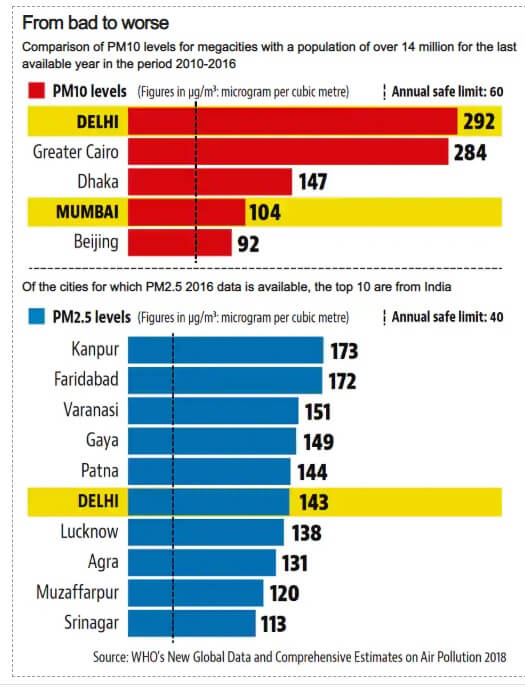
WHO report on Pollution
While the latest data show ambient air pollution levels are still dangerously high in most parts of the world, they also show some positive progress. Countries are taking measures to tackle and reduce air pollution from particulate matter. For example, in just two years, India’s Pradhan Mantri Ujjwala Yojana Scheme has provided some 37 million women living below the poverty line with free LPG connections to support them to switch to clean household energy use. Mexico City has committed to cleaner vehicle standards, including a move to soot-free buses and a ban on private diesel cars by 2025.
How China is fighting with Air Pollution
China released, Air Pollution Action Plan, in September 2013, which helped China to make significant improvements to air quality by setting PM2.5 targets for key regions. The incredible pace of industrialisation in China greatly increased the demand for power. This led to the proliferation of coal power stations which vastly increased CO2 emissions and became a major contributor to air pollution. To do so, Beijing closed its coal-fired power stations and banned people in surrounding areas from burning coal for heat. These measures were costly and controversial, but they enabled the city to achieve an annual average PM2.5 level of 58µg/m³ – a drop of 35%. In the end, China’s three biggest city clusters (Beijing-Tianjin-Hebei, and the Pearl and Yangtze deltas) all beat their targets. But even so, no Chinese city yet reaches the World Health Organization’s recommended annual average PM2.5 level of 10µg/m³.
In Jul 2018, China came up with 2018-2020 Three-year Action Plan for Winning the Blue Sky War which will apply to all these cities. (The 2013 Action Plan only set PM2.5 targets for the city clusters of Beijing-Tianjin-Hebei and the Pearl and Yangtze Deltas.)The new action plan focuses more on ozone, which is created when volatile organic compounds (VOCs) react with nitrogen oxides. It adds targets for both VOCs and nitrogen oxides; emissions reductions of 10% and 15%, respectively, by 2020 (again on a 2015 baseline). Ref: China releases 2020 action plan for air pollution
Face Mask and Air Pollution
Masks are filters that prevent fine particles from entering the nasal passage and then the lungs. The finer the particles that a mask filters, the more dense texture of the mask is.
The primary function of masks is to filter out certain particles from the air. For effective protection, it is important to wear a well-fitting mask of the correct size, which covers the nose, mouth and chin completely without leaving any gaps.
But masks don’t block everything toxic in the air. They may protect the wearer against particulate matter but are ineffective against nitrates, sulphur dioxide, carbon monoxide, lead and other gaseous pollutants. Different pollutants cause different reactions in the human body, and respiratory diseases are only one of the many ailments.
Types of Face Masks
A face mask is one of the first lines of defence against the adverse effects of air pollution, but it only targets the effects and not the root causes. Masks are of various types:
- Surgical mask or flat mask that doctors wear. They’re meant to help contain the wearer’s bacteria and viruses from getting out, not the other way around. Should be disposed of after each use.
- N Series: Used for protection against exposure to vehicular emission, smog, dust and in sterile atmospheres. Available in N95 and N99 varieties. The N95 and N99 descriptors mean that in test conditions, the respirator blocks at least 95% to 99% of very small (0.3 microns) particles, respectively.
- P Series: The major difference between P-rated and N-rated air masks is P rated masks can filter out oil-based pollutants, which the N Series cannot. Used for protection against industrial grade pollutants and particulate matter, including oily particulate matter
- R Series: Similar to P series, but higher build quality. R95 type air masks, which also filter out the oil-based pollutants, but these are really meant only for industrial use. These are only supposed to have a usable life of eight hours, and are pretty expensive, so it’s not something you should consider for everyday usage.
There are also CV marked masks which are better at filtering out specific pollutants as given below. The CV marked masks are more effective in combating air pollutants and keeping you safe than the non-CV marked masks.
- The C in CV stands for the activated carbon filter. In addition to combating foul smell, this filter helps in fighting pollutants like Ozone and Sulphur Dioxide.
- The V signifies that the said mask has a built-in valve for the air we exhale, which prevents fogging or moisture retention inside the mask.
Examples of Face Masks in India
| N95 (and above) Masks | Price |
|---|---|
| 3M 8210 | Rs. 100 |
| Honeywell H801 | Rs. 449 (for 3) |
| 3M Aura | Rs. 249 |
| Dettol Siti Shield Protect+ | Rs. 249 |
| Atlanta Healthcare Cambridge | Rs. 1,599 |
| Vogmask | Rs. 2,000 |
| Respro Techno | Rs. 2,999 |
| Totobobo | Rs. 5,351 |
A mask is only as effective as the fitting on your face, gaps between the mask and your skin will allow for pollutants to enter your nasal passage and cause health issues. Things to keep in mind before buying a mask
- Don’t choose the cheapest option. Choose the one that’s most likely to do the best job.
- Look for masks that have at least an N95 rating.
- Check the material to ensure if it can filter small particles i.e. PM 2.5.
- Buy the mask that fits you properly.
- Check for proper ventilation (mask should not make you feel suffocated).
- Check for how many hours can it be used.
Video on How to choose the best pollution mask
Air Purifiers
Air purifiers are devices that clean the indoor air by removing impurities such as dust particles, pollen, smoke and other airborne irritants. Their aim is to typically provide uncontaminated air, though many companies also claim that their purifiers reduce allergic reactions and asthma attacks. Air purifiers cost anywhere between Rs 15,000 and Rs 95,000.
Air Purifiers are different because they use different technologies, Various technologies are associated with Air Purifier. Some of these are HEPA(High Efficiency Particulate Air or high-efficiency particulate arresting), Ionizer, Ultraviolet lamp, Carbon filter and Ozone generators.
Comparison of Air Purifier Technology is given below. Our article How to buy an Air Purifier? covers it in detail
| Type of Purifier | Size of Particles Removed | Removes Allergens (dust, pollen, mold spores) | Removes Bacteria | Removes Odors | Removes Viruses & Germs | Removes Cigarette Smoke | Removes Chemical Fumes |
| HEPA | down to 0.3 microns | Yes | some bacteria | No | No | no | no |
| Ionizer | down to 0.1 microns | Yes | Yes | no | viruses | Yes | some |
| Ultra Violet Lamp | – | Some | Yes | no | Yes | no | no |
| Carbon Filter | – | Some | some | Yes | no | Yes | Yes |
| Ozone Generator | – | No | some | Yes | some | Yes | some |
We have to ask what are we doing to our children, and the answer is we are polluting their future. We need to raise awareness on Air Pollution and

